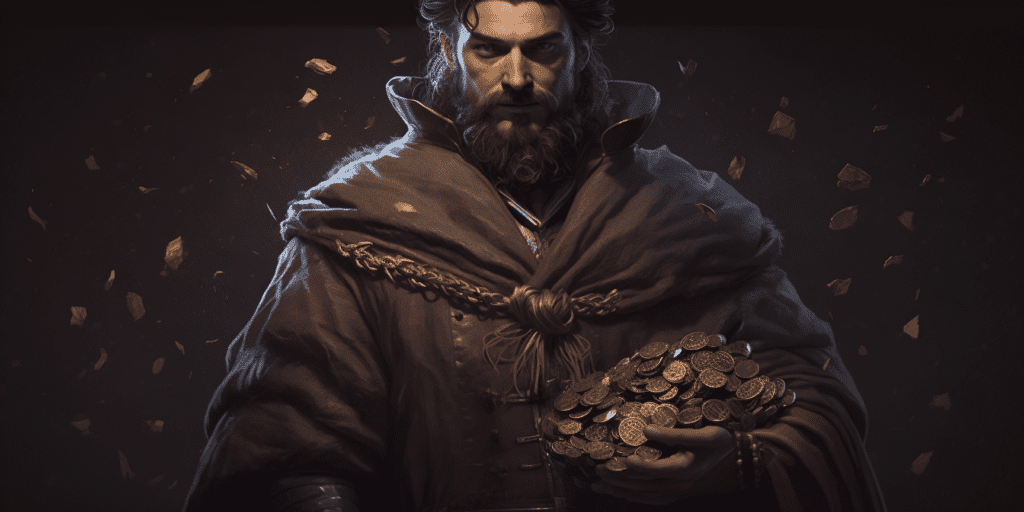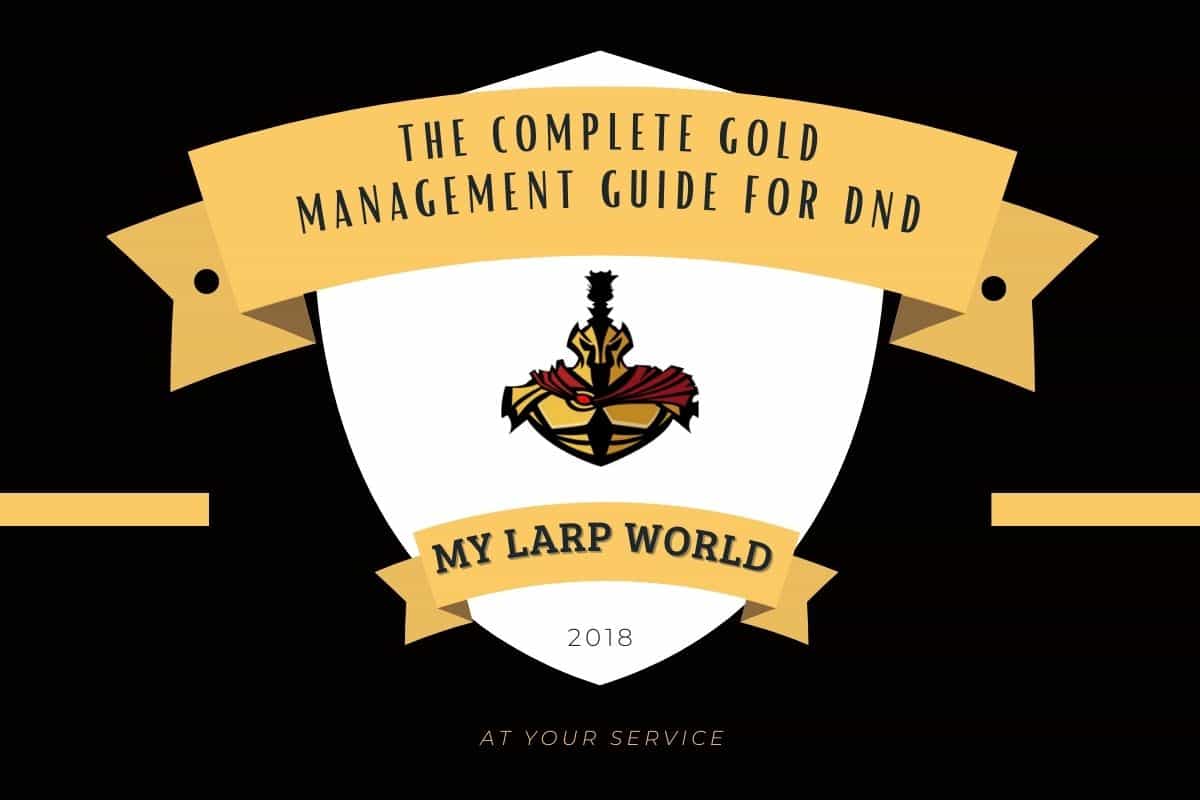Gold is the currency used in Dungeons and Dragons for players to purchase equipment, hire services, buy off guards, and for a bunch of other possible transactions. The Dungeon Master is the one responsible for handling the game’s economy, which is done with the help of various systems.
When players purchase items, they will most likely try to haggle with the NPCs to push down the prices of items as much as possible. This is done by pointing out flaws with the item, using the character’s reputation and standing, or persuading the shopkeeper to lower the price in any imaginable way.
Failing to balance the game’s economy can break the game, as players will have gold in abundance or be left with too little. When players can purchase a merchant’s entire inventory in one swoop, you’ll have an entire gaming session that only consists of that player haggling with the merchant.
Thankfully, the system can be adjusted on the go as it’s quite flexible.
As a Dungeon Master, you’ll benefit from learning how gold works, how it can be reduced and balanced, what systems you can use to aid you, and what you can come up with yourself to create a fun and working economical system. Continue reading as we’ll go through it all.
How Does Gold Work In DnD?

In Dungeons and Dragons, the amount of gold distributed to the player characters is determined by the Dungeon Master. The dungeon master must take some things into consideration when evaluating the group’s need for cash. These things include:
- The lifestyle the characters are accustomed to.
- How challenging the Dungeon Master wants the adventure to be.
- How item-focused the adventure is.
- The level of the players.
- What the cost of living is in said adventure.
- How much experience the party is rewarded from an encounter.
- The number of different things players can access with gold during the adventure.
The Dungeon Master will then distribute gold to each character at the start of the game. The amount of gold a character receives is often based on the character’s class and background. The amount can vary from one edition of the game to the next.
In the fifth edition Player’s Handbook, any character starting out can receive somewhere between 2d4 and 5d4 gold each. Their class and background determine their dice roll, but more on that later. The DM can also distribute extra gold at the start to players with certain backgrounds or traits, for instance.
This is, however, entirely up to the Dungeon Master and not something that should be expected.
Other than the starting gold, players can also earn gold by:
- Finding loot: Player characters will find treasures as they explore the world and defeat monsters. Dungeons and monsters often carry valuable objects, coins, gems, and other items.
- Selling items: The aforementioned treasures and other unwanted items can be sold to merchants.
- Character skills: Gold can also be earned by using character skills creatively. These skills can include crafting or thievery. Acquiring gold through illegal means can have consequences.
- Rewards: Player characters are often given gold or other rewards when they have completed a mission that a non-player character has sent them on. The more your party has adventured and encountered during a day, the more they should be awarded for their troubles.
- Advancement: As characters level up, they’re often allowed to access missions that pay very well and participate in adventures full of treasures, or tournaments with rewards.
With that said, the different methods a player can earn gold through are influenced by the Dungeon Master and often determined by the edition of the game that is being played. Something that can be used as a guideline is the amount of XP budget the party has used up between rests.
How Much Gold Should Players Start With In DnD?
The amount of gold each player should start with depends on the edition of the game that is being played. In the 5th edition of Dungeons and Dragons, the Player’s Handbook uses character background and class as a way to determine the character’s starter budget and equipment.
With that said, the Player’s Handbook doesn’t have the last say. Any amount of gold prescribed to a character (based on background and class) can then be modified by the Dungeon Master to balance wealth or for reasons that might be implemented into the story.
Both of these methods are used frequently, and both can result in great campaigns.
While going for the starting equipment and gold given to you based on your background is usually the most lucrative and safest option, rolling for gold can help you amass an initial fortune – but there’s the possibility of rolling low and ending up broke.
Let’s break down the numbers for both of them, starting with random rolls.
Starting Gold By Class Rolls
When rolling for wealth, the type of dice that is used will vary from class to class. The number that is rolled is then multiplied by 10. That is the amount of gold the player will receive.
There’s a slight exception when it comes to monks, though. Anyone playing a monk should not multiply the dice roll by 10. Their initial gold is reduced because there’s very little need for gold as a monk in the starting stages of a campaign.
| Class | Starting Gold |
| Barbarian | 2d4 x 10 gp |
| Bard | 5d4 x 10 gp |
| Cleric | 5d4 x 10 gp |
| Druid | 2d4 x 10 gp |
| Fighter | 5d4 x 10 gp |
| Monk | 5d4 gp |
| Paladin | 5d4 x 10 gp |
| Ranger | 5d4 x 10 gp |
| Rogue | 4d4 x 10 gp |
| Sorcerer | 3d4 x 10 gp |
| Warlock | 4d4 x 10 gp |
| Wizard | 4d4 x 10 gp |
Starting Gold By Background
If you don’t fancy the idea of rolling for your gold, then distributing gold and starting equipment based on the background is a good alternative. You can also allow players to trade their starting equipment for other valuables.
If you take a look at the amount of gold any character is expected to start with based on the Player’s Handbook, it looks something like this.
| Background | Starting GP |
| Acolyte | 15gp |
| Anthropologist (ToA) | 10gp |
| Archaeologist (ToA) | 25gp |
| Charlatan (PHB) | 15gp |
| City Watch / Investigator (SCAG) | 10gp |
| Clan Crafter (SCAG) | 5gp gem and 10gp |
| Cloistered Scholar (SCAG) | 10gp |
| Courtier (SCAG) | 5gp |
| Criminal / Spy | 15gp |
| Entertainer (PHB) | 15gp |
| Faction Agent (SCAG) | 15gp |
| Far Traveler (SCAG) | 10gp jewelry and 5gp |
| Folk Hero | 10gp |
| Gladiator (PHB) | 15gp |
| Guild Artisan/Merchant (PHB) | 15gp |
| Haunted One (COS) | None |
| Hermit (PHB) | 5gp |
| Inheritor (SCAG) | 15gp |
| Knight (PHB) | 25gp |
| Knight of the Order (SCAG) | 10gp |
| Mercenary Veteran (SCAG) | 10gp |
| Noble | 25gp |
| Outlander (PHB) | 10gp |
| Pirate (PHB) | 10gp |
| Sage | 10gp |
| Sailor (PHB) | 10gp |
| Soldier | 10gp |
| Urban Bounty Hunter (SCAG) | 20gp |
| Urchin (PHB) | 10gp |
| Uthgardt Tribe Member (SCAG) | 10gp |
| Waterdhavian Noble (SCAG) | 20gp |
Starting Gold For Characters Starting Above Level 1
Not all campaigns start out at level 1. Some players prefer to start out in the middle of things, where their characters have and need more resources than a character starting out at level 1. It wouldn’t make sense to let a level 10 character start with the same budget as a level 1 character.
It would, in fact, impair the character as the challenges the characters face on their journey get progressively harder. While characters gain spells and abilities as they level up, there’s still a need for equipment upgrades, magic items, and other utilities that can be purchased with gold.
Failing to distribute a fair amount of gold to characters starting above level 1 can put the party in a position that is quite hard to advance from.
In Dungeons and Dragons 3.5, players were given a chart that showed how much gold characters of any level should start out with. However, no such chart is provided in the latter handbooks.
Thankfully, the Dungeon Master’s Guide estimates a good starting kit. These estimations are based on hours and hours of testing. With that said, it is stated that these numbers are only guidelines and that you can adjust them to your liking.
| Character Level | Low Magic Campaign | Standard Campaign | High Magic Campaign |
| 1st – 4th | Normal Starting Equipment & Gold | Normal Starting Gold & Equipment | Normal Starting Equipment & Gold |
| 5th – 10th | 500gp plus 1d10x 25gp, normal starting equipment | 500gp plus 1d10x25gp, normal starting equipment | 500gp plus 1d10x25gp, one uncommon magic item, normal starting equipment |
| 11th-16th | 5,000gp plus 1d10x250gp, one uncommon magic item, normal starting equipment | 500gp plus 1d10x250 gp, two uncommon magic items, normal starting equipment | 5,000gp plus1d10x250gp, three uncommon magic items, one rare item, normal starting equipment |
| 17th+ | 20,000gp plus 1d10x250gp, two uncommon magic items, normal starting equipment | 20,000gp plus 1d10x250gp, two uncommon magic items, one rare item, normal starting equipment | 20,000gp plus d10x250gp, three uncommon magic items, two rare items, one very rare item, normal starting equipment |
How Much Gold Should Players Have at Each Level?
Some will state that there’s no such recommended amount and that a character’s wealth in Dungeons and Dragons will vary from one campaign to the next, while others have made calculations that show the average amount of gold any character should have at any level.
If the game deviates from the norm and implements other mechanics, such as investments, then the players will most likely have either more or less gold than usual depending on how their investments turned out.
If a game doesn’t deviate from the norm, chances are the amount of gold each character in the party has will be more aligned with what is expected at each level.
This list provides a breakdown of the expected wealth that players will earn in Dungeons and Dragons, based on using only the Treasure Hoard tables in the Dungeon Master’s Guide. The calculations do not include magic items.
The breakdown includes average rolls for each tier, a subjective distribution of rolls throughout each tier, and an average party wealth for each level. The numbers are cumulative and assume a party of four.
The breakdown is meant as a tool for DMs, but does not account for expenditures on gear or lifestyle expenses.
| Level | Gold Pieces |
| 1 | Starting Gear |
| 2 | 94 gold pieces |
| 3 | 188 gold pieces |
| 4 | 376 gold pieces |
| 5 | 658 gold pieces |
| 6 | 2,930 gold pieces |
| 7 | 5,404 gold pieces |
| 8 | 8,610 gold pieces |
| 9 | 12,019 gold pieces |
| 10 | 16,563 gold pieces |
| 11 | 21,108 gold pieces |
| 12 | 30,161 gold pieces |
| 13 | 39,214 gold pieces |
| 14 | 57,320 gold pieces |
| 15 | 75,427 gold pieces |
| 16 | 102,586 gold pieces |
| 17 | 129,745 gold pieces |
| 18 | 214,204 gold pieces |
| 19 | 383,123 gold pieces |
| 20 | 552,042 gold pieces |
| 20+ | 805,420 gold pieces |
What Should Players Spend Gold On In DnD?
Gold can be used to acquire various objects in Dungeons and Dragons. Generally, players spend gold to upgrade their equipment and armor and to purchase items that can aid them in their adventures, but gold can be used for much more than that. Such as:
- Training: If a player wants to learn a new skill or improve an existing one, the player can pay an expert to help them master the skill.
- Spellcasting Services: If no one in the party has the ability to cast a spell because the spell is too difficult to cast or requires a high level of skill, then gold can be used to trade for such services from someone who has mastered the skill.
- Property: Players can also use their accumulated gold to purchase property, be it a home or a piece of land to build a house on. The player’s home can then be used as a haven to rest, store equipment, and plan for future adventures – safely.
- Gambling: There’s gambling in Dungeons and Dragons in the form of card or dice games where players can gamble their money between adventures. This should, however, be done with caution as you can easily empty your entire gold pouch if you’re on a losing streak.
- Donations: If your character is quite the philanthropist, then he or she might want to donate money to a local church, community, or person in need.
- Titles: If given the chance, player characters can spend gold to receive unique titles.
Players should find a balance between their long-term investments such as property and skill, and their short-term investments such as equipment, armor, and supplies. Remember to not spend all of your gold at once, leaving you with nothing when you might need it the most. Keep spare gold for unexpected expenses.
Can You Reduce Funds For Players?

Miscalculating the player’s need for money and the amount of gold they accumulate during their adventures can cause their characters to snowball through the game as they garner large fortunes. Generous Dungeon Masters will put the party in this situation, which might seem beneficial for them – but cause imbalance.
Can you, as a Dungeon Master, reduce the players’ funds?
Yes, but upright stripping the players of their gold without justification is not going to do wonders for their trust in you as a moderator of the game and it won’t make sense either.
However, you have every possibility in the world to fabricate interesting ways for them to spend their gold, minimizing the redundancy and increasing the enjoyment of the game.
Create an attractive offer that the players might want to spend their money on and once the balance has been restored, be cautious with the amount of gold you give out for the remainder of the campaign.
Here are a couple of gold-balancing methods drawn from our own campaigns over the years.
- Offer the party property in the form of a stronghold, castle, temple, mansion, or any other type of home base with utilities that they fancy. Have them pay a large portion of their collective gold for the property in order to re-balance the economy.
- Manipulate the economy by increasing the price of items that the party wants, this will force them to burn through their savings to access these items.
- Have them spend money on services that they would otherwise use for free or very cheap. They could, for instance, need to pay a toll to pass through certain areas.
- Take them somewhere where their currency holds no value or very little value. In a place where the economy isn’t as developed, a gold coin might not hold the same value as it would in a flourishing town. Some tribes might value other things over gold, making the price of things more expensive when purchased with gold.
- Have a thief approach the party. The outcome of the encounter could be that the party is stripped of a portion of their gold. Give them the chance to recover a part of it or defend their gold by letting them roll to hide your intentions.
What’s Considered Rich In Dungeons and Dragons?

What’s considered rich? Is it when a character no longer needs anything because everything of value already belongs to the character? Is it when gold is no issue and the character can purchase everything he or she wants? Is it when he or she can get by?
Well…
According to the 5e Player’s Handbook:
A “Modest” lifestyle costs 1 gold a day, so doubling that for disposable income too gives you 730 gold per year.
A “Wealthy” lifestyle costs 4 gold per day, so doubling that for disposable income gives you 2,920 gold per year.
An “Aristocratic” lifestyle costs 10+ gold per day, doubling for disposable income gives you 7,300 gold per year and up.
I would say that anyone who’s living a wealthy/aristocratic lifestyle is rich and has enough money to purchase powerful items and other valuables is rich. But I also think that the first sign of fortune is when someone stops buying things from The Player’s Handbook.
Ultimately, managing gold and balancing it properly is a key ingredient when making a good campaign. Now that you’ve read this guide I’m sure you’ve got every piece of information you could need to balance your campaigns and force players from snowballing through every encounter/situation they face.
Thank you for reading.

